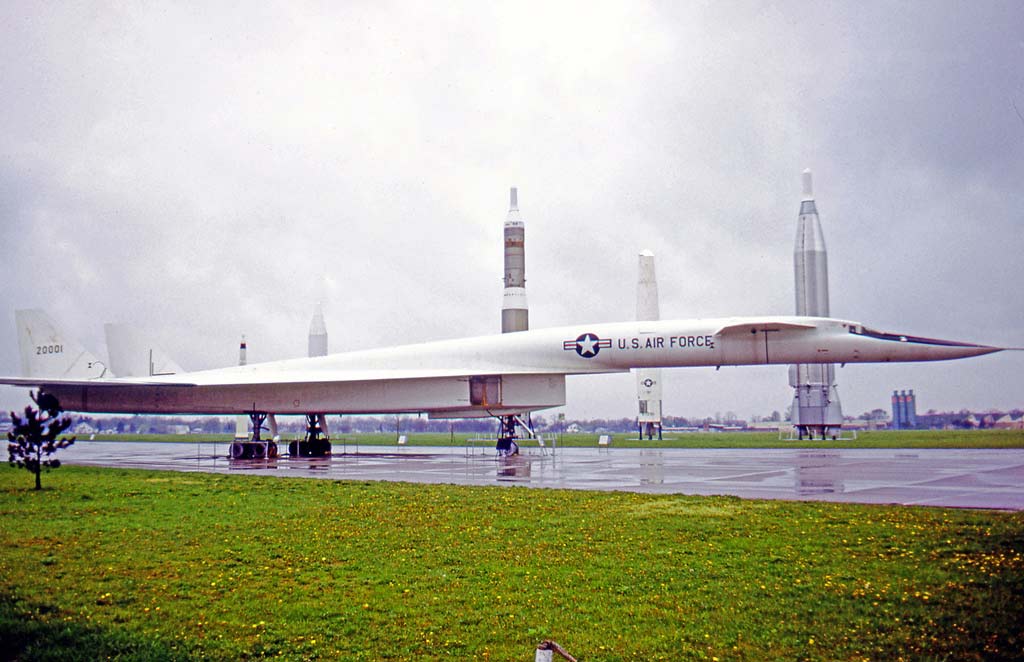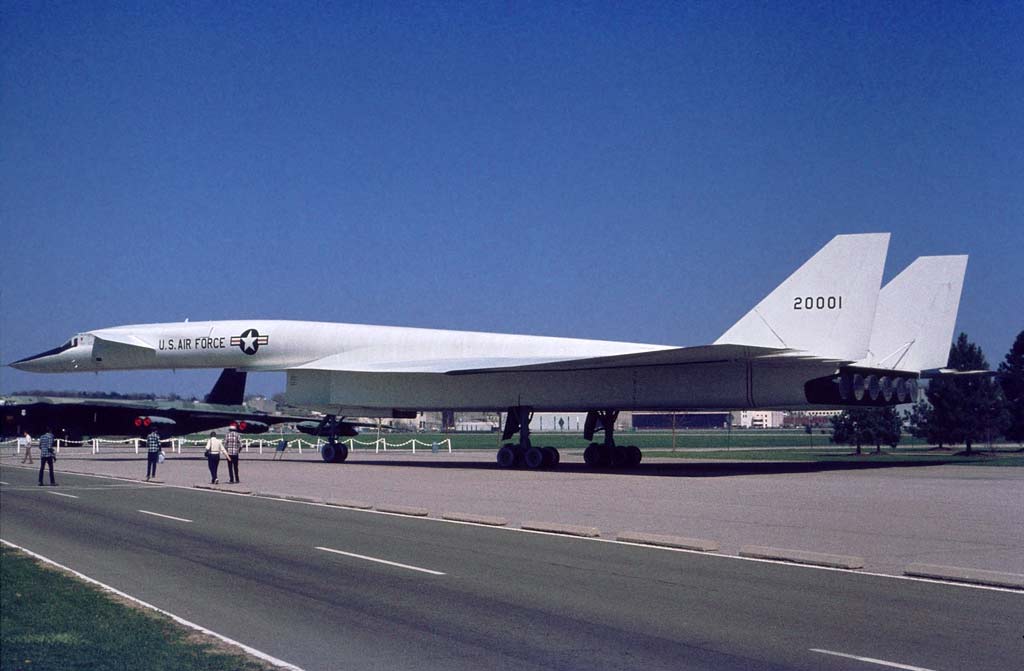The North American XB-70 Valkyrie was a prototype supersonic bomber capable of Mach 3 flight, designed during the Cold War for nuclear strike missions.
In Brief
The XB-70 Valkyrie was an ambitious strategic bomber project from North American Aviation, aiming to fly at Mach 3+ speeds at high altitudes to outpace Soviet defenses during the Cold War. Featuring a distinctive delta wing and six turbojet engines, it utilized compression lift and variable-geometry wingtips for stability and efficiency at high speeds. Although only two prototypes were built, the aircraft demonstrated groundbreaking aerospace technologies, but its relevance was overshadowed by missile advancements and changing military strategies, leading to the program’s cancellation.

The North American XB-70 Valkyrie was conceived during the height of the Cold War, designed to be the ultimate high-altitude, high-speed strategic bomber, capable of outrunning Soviet interceptors and surface-to-air missiles. This revolutionary aircraft combined speed, altitude, and range, pushing the boundaries of aerospace technology.
History of the Development of the North American XB-70 Valkyrie
In the late 1950s, the United States Air Force (USAF) sought a new strategic bomber that could deliver nuclear payloads deep into Soviet territory, evading the increasingly sophisticated air defense systems of the era. The North American Aviation company was awarded the contract to develop this advanced bomber, which resulted in the XB-70 Valkyrie, a six-engine, delta-winged aircraft designed to cruise at speeds exceeding Mach 3 and altitudes above 70,000 feet.
The Valkyrie was a response to the perceived need for a capable and invulnerable strategic bomber in an age where long-range ballistic missiles had not yet completely overshadowed manned aircraft. The program was launched amidst intense competition with the USSR’s own strategic programs and aimed to maintain a technological and strategic edge.
The first flight of the XB-70 occurred on September 21, 1964, marking the beginning of a short-lived but historically significant flight test program. The aircraft was designed to utilize high-speed, high-altitude flight to avoid interception, incorporating advanced aerodynamic and propulsion technologies.
However, the strategic landscape changed rapidly during the XB-70’s development. Advances in surface-to-air missile technology and the rising prominence of intercontinental ballistic missiles (ICBMs) challenged the need for such a bomber. The high costs, political shifts, and evolving military strategies led to the eventual cancellation of the XB-70 program, with only two prototypes ever built. The aircraft did not receive a NATO nickname as it never entered operational service.
Design of the North American XB-70 Valkyrie
The XB-70 Valkyrie showcased several innovative design features tailored to its high-speed, high-altitude mission profile. The aircraft’s airframe was primarily constructed from stainless steel and titanium, materials chosen for their strength and heat resistance, as the aircraft’s surfaces could reach temperatures exceeding 330°C (625°F) during Mach 3 flight.
The Valkyrie’s most notable design feature was its variable-geometry wingtips, which could be folded down to 65 degrees to enhance stability and provide compression lift, increasing the aircraft’s efficiency at supersonic speeds. This delta-wing configuration, combined with the six General Electric YJ93-GE-3 turbojet engines, allowed the XB-70 to achieve speeds of Mach 3+ and operate at altitudes up to 77,000 feet.
The aircraft was equipped with sophisticated navigation and bombing systems, enabling it to perform precise, high-speed, long-range strategic bombing missions. Its large payload capacity was designed to carry a significant amount of nuclear ordnance.
Despite its advanced design, the XB-70 faced several drawbacks. The intense heat generated at high speeds presented challenges for both the airframe and onboard systems. The aircraft’s immense size and complexity made it expensive to build and operate. Additionally, its mission profile became increasingly obsolete with the advent of more advanced ICBM systems, which offered a more cost-effective and less risky means of delivering nuclear payloads.
Performance of the North American XB-70 Valkyrie
The XB-70 Valkyrie’s performance was extraordinary, pushing the boundaries of what was possible with 1960s aviation technology. Powered by six GE YJ93-GE-3 turbojet engines, each producing 30,000 pounds of thrust with afterburner, the aircraft could reach speeds over Mach 3 (approximately 2,000 mph or 3,219 km/h) and operate at altitudes up to 77,000 feet (23,470 meters).
This incredible speed and altitude capability meant the Valkyrie could theoretically outrun any Soviet fighter or missile in existence at the time. Its range was equally impressive, designed to conduct deep penetration strategic bombing missions without refueling. However, the aircraft’s operational effectiveness was mitigated by advancements in radar and surface-to-air missile technology, which increased the vulnerability of high-flying, fast-moving aircraft.
In comparison to its contemporaries, the XB-70 had no equal in terms of speed and operational ceiling. The closest competitor, the Soviet MiG-25 Foxbat, was capable of Mach 2.83 but was primarily an interceptor, not a bomber. The SR-71 Blackbird, another high-speed aircraft developed in the USA, was designed for reconnaissance and not equipped with the Valkyrie’s bombing capabilities.
Variants of the North American XB-70 Valkyrie
The XB-70 program consisted of only two prototypes:
- XB-70A AV-1: The first Valkyrie prototype, which primarily conducted test flights to evaluate the aircraft’s performance, handling, and unique features like its foldable wingtips.
- XB-70A AV-2: The second prototype incorporated modifications based on experiences from the AV-1. It was used to further test the aircraft’s performance, including high-speed, high-altitude capabilities, and unfortunately, was destroyed in a mid-air collision in 1966.
No further variants were developed, as the program was canceled before additional prototypes or production models could be built.

Military Use and Combat of the North American XB-70 Valkyrie
The XB-70 Valkyrie was never used in combat nor operational military service. Its development coincided with a shift in strategic military doctrine, increasingly favoring ICBMs over manned bombers for nuclear deterrence. The Valkyrie’s intended role as a high-speed, high-altitude bomber was rendered less relevant by the advancements in missile technology and the changing nature of the nuclear threat.
The prototypes were used extensively in test flights to gather data on high-speed flight, materials engineering, and aerodynamics. While the XB-70 provided valuable research insights, particularly influencing future supersonic aircraft design, it did not result in an operational aircraft fleet due to its high cost, changing strategic requirements, and emerging missile technologies that offered alternative strategic deterrent capabilities.
The North American XB-70 Valkyrie was a pinnacle of Cold War aviation technology, representing an audacious leap in aircraft design and performance. Despite its cancellation, the XB-70 served as a crucial platform for high-speed flight research, contributing valuable data that influenced future aerospace designs. Its legacy is reflected in the technological advancements it pioneered, which have had lasting impacts on the fields of aerodynamics, materials science, and aircraft engineering. The Valkyrie remains a symbol of the ambitious, boundary-pushing spirit of its era, a remarkable testament to the ingenuity and aspirations of Cold War aerospace engineering.
Back to the experimental aircraft section.